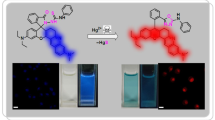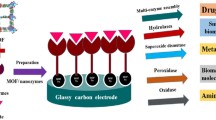Abstract
Dual-emissive fluorescence probes were designed by integrating porphyrin into the frameworks of UiO-66 for ratiometric fluorescence sensing of amoxicillin (AMX). Porphyrin integrated UiO-66 showed dual emission in the blue and red region. AMX resulted in the quenching of blue fluorescence component, attributable to the charge neutralization and hydrogen bonds induced energy transfer. AMX was detected using (F438/F654) as output signals. Two linear relationships were observed (from 10 to 1000 nM and 1 to 100 µM), with a limit of detection of 27 nM. The porphyrin integrated UiO-66 probe was used to detect AMX in practical samples. This work widens the road for the development of dual/multiple emissive fluorescence sensors for analytical applications, providing materials and theoretical supporting for food, environmental, and human safety.
Graphical Abstract






Similar content being viewed by others
References
Yazidi A, Atrous M, Edi Soetaredjo F, Sellaoui L, Ismadji S, Erto A, Bonilla-Petriciolet A, Luiz Dotto G, Ben Lamine A (2020) Adsorption of amoxicillin and tetracycline on activated carbon prepared from durian shell in single and binary systems: experimental study and modeling analysis. Chem Eng J 379:122320
Andreozzi R, Caprio V, Ciniglia C, de Champdoré M, Lo Giudice R, Marotta R, Zuccato E (2004) Antibiotics in the environment: occurrence in Italian STPs, fate, and preliminary assessment on algal toxicity of amoxicillin. Environ Sci Technol 38(24):6832–6838
Patel M, Kumar R, Kishor K, Mlsna T, Pittman CU Jr, Mohan D (2019) Pharmaceuticals of emerging concern in aquatic systems: chemistry, occurrence, effects, and removal methods. Chem Rev 119(6):3510–3673
Aryee AA, Han R, Qu L (2022) Occurrence, detection and removal of amoxicillin in wastewater: a review. J Cleaner Prod 368:133140
Yang C-W, Liu C, Chang B-V (2020) Biodegradation of amoxicillin, tetracyclines and sulfonamides in wastewater sludge. Water 12(8):2147
ul Ain N, Anis I, Ahmed F, Shah MR, Parveen S, Faizi S, Ahmed S (2018) Colorimetric detection of amoxicillin based on querecetagetin coated silver nanoparticles. Sens Actuators B 265:617–624
Nag P, Sadani K, Mohapatra S, Mukherji S, Mukherji S (2021) Evanescent wave optical fiber sensors using enzymatic hydrolysis on nanostructured polyaniline for detection of β-lactam antibiotics in food and environment. Anal Chem 93(4):2299–2308
De Baere S, Cherlet M, Baert K, De Backer P (2002) Quantitative analysis of amoxycillin and its major metabolites in animal tissues by liquid chromatography combined with electrospray ionization tandem mass spectrometry. Anal Chem 74(6):1393–1401
Hermo MP, Saurina J, Barbosa J, Barrón D (2014) High-resolution mass spectrometry applied to the study of metabolome modifications in various chicken tissues after amoxicillin administration. Food Chem 153:405–413
Santos L, Ramos F (2016) Analytical strategies for the detection and quantification of antibiotic residues in aquaculture fishes: a review. Trends Food Sci Technol 52:16–30
Ayankojo AG, Reut J, Öpik A, Furchner A, Syritski V (2018) Hybrid molecularly imprinted polymer for amoxicillin detection. Biosens Bioelectron 118:102–107
Sanli S (2024) Single-drop electrochemical immunosensor with 3D-printed magnetic attachment for onsite smartphone detection of amoxicillin in raw milk. Food Chem 437:137823
Prakashan D, Kolhe P, Gandhi S (2024) Design and fabrication of a competitive lateral flow assay using gold nanoparticle as capture probe for the rapid and on-site detection of penicillin antibiotic in food samples. Food Chem 439:138120
Attia KAM, Nassar MWI, El-Zeiny MB, Serag A (2016) Different spectrophotometric methods applied for the analysis of binary mixture of flucloxacillin and amoxicillin: a comparative study. Spectrochim Acta Part A 161:64–69
Saini A, Singh J, Kaur R, Singh N, Kaur N (2015) Fluoremetric determination of amoxicillin drug in aqueous medium using hybrid framework of organic–inorganic nanoparticles. Sens Actuators B 209:524–529
Pawar SP, Walekar LS, Gunjal DB, Dalavi DK, Gore AH, Anbhule PV, Patil SR, Kolekar GB (2017) Fluorescence-based sensor for selective and sensitive detection of amoxicillin (Amox) in aqueous medium: application to pharmaceutical and biomedical analysis. Lumin 32(6):918–923
Li S, Ma X, Pang C, Li H, Liu C, Xu Z, Luo J, Yang Y (2020) Novel molecularly imprinted amoxicillin sensor based on a dual recognition and dual detection strategy. Anal Chim Acta 1127:69–78
Chen L, Liu D, Peng J, Du Q, He H (2020) Ratiometric fluorescence sensing of metal-organic frameworks: tactics and perspectives. Coord Chem Rev 404:213113
Wu S, Min H, Shi W, Cheng P (2020) Multicenter metal–organic framework-based ratiometric fluorescent sensors. Adv Mater 32(3):1805871
Li L, Yang L, Lin D, Xu S, Mei C, Yu S, Jiang C (2023) Hydrogen-bond induced enhanced emission ratiometric fluorescent handy needle for visualization assay of amoxicillin by smartphone sensing platform. J Hazard Mater 444:130403
Wang Q, Astruc D (2020) State of the art and prospects in metal–organic framework (MOF)-based and MOF-derived nanocatalysis. Chem Rev 120(2):1438–1511
O’Keeffe M, Yaghi OM (2012) Deconstructing the crystal structures of metal–organic frameworks and related materials into their underlying nets. Chem Rev 112(2):675–702
Allendorf MD, Bauer CA, Bhakta RK, Houk RJT (2009) Luminescent metal–organic frameworks. Chem Soc Rev 38(5):1330–1352
Samanta P, Let S, Mandal W, Dutta S, Ghosh SK (2020) Luminescent metal–organic frameworks (LMOFs) as potential probes for the recognition of cationic water pollutants. Inorg Chem Front 7(9):1801–1821
Haldar R, Bhattacharyya S, Maji TK (2020) Luminescent metal–organic frameworks and their potential applications. J Chem Sci 132(1):99
Chen J, Zhu Y, Kaskel S (2021) Porphyrin-based metal–organic frameworks for biomedical applications. Angew Chem Int Ed 60(10):5010–5035
Cavka JH, Jakobsen S, Olsbye U, Guillou N, Lamberti C, Bordiga S, Lillerud KP (2008) A new zirconium inorganic building brick forming metal organic frameworks with exceptional stability. J Am Chem Soc 130(42):13850–13851
Zhang X, Wasson MC, Shayan M, Berdichevsky EK, Ricardo-Noordberg J, Singh Z, Papazyan EK, Castro AJ, Marino P, Ajoyan Z, Chen Z, Islamoglu T, Howarth AJ, Liu Y, Majewski MB, Katz MJ, Mondloch JE, Farha OK (2021) A historical perspective on porphyrin-based metal–organic frameworks and their applications. Coord Chem Rev 429:213615
Tereshchenko AA, Butova VV, Guda AA, Burachevskaya OA, Bugaev AL, Bulgakov AN, Skorynina AA, Rusalev YV, Pankov IV, Volochaev VA, Al-Omoush M, Ozhogin IV, Borodkin GS, Soldatov AV (2022) Rational functionalization of UiO-66 with Pd nanoparticles: synthesis and in situ fourier-transform infrared monitoring. Inorg Chem 61(9):3875–3885
Butova VV, Budnyk AP, Guda AA, Lomachenko KA, Bugaev AL, Soldatov AV, Chavan SM, Øien-Ødegaard S, Olsbye U, Lillerud KP, Atzori C, Bordiga S, Lamberti C (2017) Modulator effect in UiO-66-NDC (1,4-naphthalenedicarboxylic acid) synthesis and comparison with UiO-67-NDC isoreticular metal–organic frameworks. Cryst Growth Des 17(10):5422–5431
Nam D-H, Shekhah O, Lee G, Mallick A, Jiang H, Li F, Chen B, Wicks J, Eddaoudi M, Sargent EH (2020) Intermediate binding control using metal–organic frameworks enhances electrochemical CO2 reduction. J Am Chem Soc 142(51):21513–21521
Naik TSK, Singh S, Pavithra N, Varshney R, Uppara B, Singh J, Khan NA, Singh L, Arshad MZ, Ramamurthy PC (2023) Advanced experimental techniques for the sensitive detection of a toxic bisphenol A using UiO-66-NDC/GO-based electrochemical sensor. Chemosphere 311:137104
Butova VV, Budnyk AP, Charykov KM, Vetlitsyna-Novikova KS, Bugaev AL, Guda AA, Damin A, Chavan SM, Øien-Ødegaard S, Lillerud KP, Soldatov AV, Lamberti C (2019) Partial and complete substitution of the 1,4-benzenedicarboxylate linker in UiO-66 with 1,4-naphthalenedicarboxylate: synthesis, characterization, and H2-adsorption properties. Inorg Chem 58(2):1607–1620
Hadjiivanov KI, Panayotov DA, Mihaylov MY, Ivanova EZ, Chakarova KK, Andonova SM, Drenchev NL (2021) Power of infrared and raman spectroscopies to characterize metal-organic frameworks and investigate their interaction with guest molecules. Chem Rev 121(3):1286–1424
Ma J, Wang S, Wang T, Ma J, Wang Z (2023) Ratiometric fluorescence assay for pyrophosphate based on sulfur nanodots decorated metal-organic frameworks. Chem Eur J 29(35):e202300366
Feng D, Chung W-C, Wei Z, Gu Z-Y, Jiang H-L, Chen Y-P, Darensbourg DJ, Zhou H-C (2013) Construction of ultrastable porphyrin Zr metal–organic frameworks through linker elimination. J Am Chem Soc 135(45):17105–17110
Ma J, Wang W, Li Y, Lu Z, Tan X, Han H (2021) Novel porphyrin Zr metal–organic framework (PCN-224)-based ultrastable electrochemiluminescence system for PEDV sensing. Anal Chem 93(4):2090–2096
Motz RN, Sun AC, Lehnherr D, Ruccolo S (2023) High-throughput determination of Stern-Volmer quenching constants for common photocatalysts and quenchers. ACS Org Inorg Au 3(5):266–273
Geethanjali HS, Nagaraja D, Melavanki RM, Kusanur RA (2015) Fluorescence quenching of boronic acid derivatives by aniline in alcohols – a negative deviation from Stern-Volmer equation. J Lumin 167:216–221
Junejo Y, Güner A, Baykal A (2014) Synthesis and characterization of amoxicillin derived silver nanoparticles: its catalytic effect on degradation of some pharmaceutical antibiotics. Appl Surf Sci 317:914–922
Funding
This work was financially supported by the National Natural Science Foundation of China (22175052), Science Fund for Creative Research Groups of Nature Science Foundation of Hebei Province (B2021201038), Central Government Guided Local Science and Technology Development Fund (Hebei, 236Z0602G), High level Talent Funding Project of Hebei Province (C20231052), and Foundation of President of Hebei University (XZJJ202211), Innovation Training Program Project for College Students (2023138).
Author information
Authors and Affiliations
Corresponding authors
Ethics declarations
Conflict of interest
The authors declare no competing interests.
Additional information
Publisher's Note
Springer Nature remains neutral with regard to jurisdictional claims in published maps and institutional affiliations.
Supplementary Information
Below is the link to the electronic supplementary material.
Rights and permissions
Springer Nature or its licensor (e.g. a society or other partner) holds exclusive rights to this article under a publishing agreement with the author(s) or other rightsholder(s); author self-archiving of the accepted manuscript version of this article is solely governed by the terms of such publishing agreement and applicable law.
About this article
Cite this article
Ma, J., Shi, Ye., Song, Q. et al. Efficient porphyrin integrated UiO-66 probes for ratiometric fluorescence sensing of antibiotic residues in milk. Microchim Acta 191, 304 (2024). https://doi.org/10.1007/s00604-024-06391-4
Received:
Accepted:
Published:
DOI: https://doi.org/10.1007/s00604-024-06391-4




